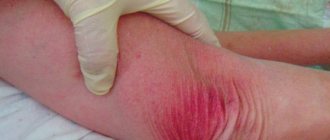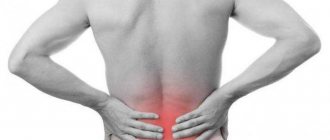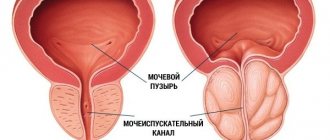Hypoglycemia is not an independent disease, but a clinical and laboratory syndrome. In diabetes, this condition occurs in approximately 40-60% of patients. Among people with type 1 diabetes, the percentage of cases of hypoglycemia is slightly higher, however, due to the much higher prevalence of type 2 diabetes, the predominant number of episodes of hypoglycemia occur in this form of diabetes. Moreover, in diabetes patients with prolonged hyperglycemia (decompensation), symptoms begin to appear already at a glucose level of 5-6 mmol/l. The maturing nervous system of children (especially newborns) uses more glucose and therefore reacts more acutely to hypoglycemia.
Causes of hypoglycemia
The condition has many etiological factors. In a healthy person, the reasons for a decrease in glucose below normal values may be pregnancy, intense physical activity, or prolonged fasting. However, such cases are extremely rare. Most often, hypoglycemia develops in various diseases and pathological conditions:
- Errors in insulin therapy for diabetes
. They are considered the most common cause of hypoglycemia. Basically, it develops if a patient who regularly injects himself with insulin skips meals, drinks alcohol, or begins to exercise. Sometimes the cause is a violation of injection technique, accidental or intentional overdose of insulin. - Hyperinsulinism.
Secretion of an inappropriately large amount of insulin into the blood by beta cells of the pancreas occurs in insulinoma, hyperplasia of the islets of Langerhans (nesidioblastosis). Also, the causes of excess production of insulin and insulin-like growth factor are some malignant tumors (carcinoma, mesothelioma). Hypoglycemia can occur in the presence of insulin autoantibodies that bind to insulin receptors (Hirata disease). - Endocrine disorders
. Deficiency of so-called contrainsular hormones, i.e. hormones with an antagonistic effect on insulin (cortisol, thyroxine, somatotropin) are observed in hypothyroidism, adrenal insufficiency, and pituitary dwarfism. - Taking medications
. In addition to insulin, other medications may cause a decrease in glucose concentration. First of all, these include medications used for type 2 diabetes (diabetic-lowering agents), which stimulate the production of insulin by the pancreas - sulfonylurea derivatives (glibenclamide), glinides (repaglinide). - Operations on the gastrointestinal tract
. Surgical interventions on the digestive organs, such as resection of the stomach or the initial part of the small intestine, lead to dumping syndrome, caused by the accelerated entry of undigested food into the intestines. As a result, insufficient breakdown and absorption of carbohydrates occurs. - Hereditary diseases
. These are severe metabolic diseases (glycogenosis, galactosemia, fructosemia), characterized by a genetically determined defect in enzymes involved in carbohydrate metabolism (glycogen, fructose, galactose). As a result of enzyme deficiency, the conversion of glucose from other carbohydrates is impaired or its release from glycogen is impaired, which causes a drop in glycemic levels.
The development of hypoglycemia is predisposed by chronic diseases in which the clearance of glucose-lowering drugs that regulate blood glucose levels is slowed down - renal and liver failure. The hypoglycemic effect of sulfonylurea derivatives is enhanced when they are taken simultaneously with sulfonamides, salicylates, and synthetic antimalarials. Hypoglycemia is also caused by slow gastric emptying (diabetic gastroparesis).
Pathogenesis
Glucose is the main energy substrate for the central nervous system. Therefore, the central nervous system is very sensitive to hypoglycemia. First, as a compensatory reaction, counter-insular hormones are released into the blood, including catecholamines (adrenaline, norepinephrine), which cause vegetative symptoms. If glucose continues to be low, neuroglycopenia occurs.
Brain cells (mainly the cerebral cortex, diencephalic structures) begin to experience energy starvation, all metabolic processes, redox reactions, etc. are inhibited in them. Persistent hypoglycemia affects the medulla oblongata and the upper parts of the spinal cord, which leads to suppression of reflexes, convulsive readiness of the brain, impaired consciousness, and coma. Pathomorphological changes include edema, necrosis of certain areas of the brain.
Classification
Detection of hypoglycemia in a blood test is not always true. False, or pseudohypoglycemia, can occur with leukocytosis, erythrocytosis. Separately, transient hypoglycemia is distinguished in newborns born to mothers with diabetes. According to the severity, hypoglycemia is divided into mild, moderate, severe, and according to its course - acute, subacute, chronic. According to etiopathogenesis, the following types of hypoglycemia are distinguished:
- Lean (spontaneous)
. Develops with excessive secretion of insulin, insulin-like factor and diseases accompanied by a deficiency of contrainsular hormones. - Reactive (postprandial)
. Occurs 2-4 hours after eating. The cause is the early stage of diabetes, hereditary metabolic disorders, post-resection syndromes, autoimmune insulin syndrome. - Induced
. Develops in diabetes, caused by drinking alcohol and medications.
Detailed symptoms
In the later stages of the pathology, pronounced symptoms of hypoglycemic shock develop:
- unbearable feeling of hunger;
- difficulty breathing;
- double vision and blurred vision;
- trembling of hands and feet;
- tachycardia;
- drop in blood pressure and body temperature;
- severe weakness;
- movement coordination disorder.
Late stages of hypoglycemia end with an attack of convulsions, loss of consciousness and the development of a coma. This poses a great danger to the patient's life.
Symptoms of hypoglycemia
The presence of symptoms and their severity may not correlate with glycemic levels. The first symptoms are caused by activation of the sympatho-adrenal system (the release of adrenaline, norepinephrine). There is a sharp and strong feeling of hunger, muscle tremors, and sweating. The cardiovascular system reacts with increased heart rate, increased blood pressure, and angina pain in the heart. Neuropsychic symptoms are added: anxiety, motor agitation, depressed mood or, conversely, a feeling of euphoria.
Characterized by paresthesia (tingling sensation in the lips, tongue, fingertips). This is the so-called adrenergic or vegetative syndrome. If hypoglycemia continues, neuroglycopenia develops. Concentration and coordination of movements deteriorate (ataxia), speech becomes slurred and slurred. The patient begins to feel sleepy, he reacts poorly to external stimuli, sometimes photopsia (lightning flashes before the eyes) and visual hallucinations appear.
Tonic-clonic seizures, reminiscent of epilepsy, indicate deep depression of the nervous system and the patient’s extremely serious condition. The development of seizures precedes hypoglycemic coma. In individuals with chronic hypoglycemia (insulinoma), the only clinical manifestation may be an intermittent headache that quickly stops after ingesting a carbohydrate meal. When glucose concentrations decrease at night, some patients experience troubled sleep or nightmares. There are also atypical hypoglycemic symptoms - nausea, vomiting, bradycardia.
Clinical signs of low glucose levels
A drop in blood sugar, regardless of the cause, has symptoms:
- decreased intellectual abilities;
- disorientation, absent-mindedness;
- euphoria;
- drowsiness;
- lethargy;
- fog, spots before the eyes;
- a sharp, uncontrollable feeling of hunger.
When examining the patient, sweating, a jump in blood pressure, tachycardia, and pale skin are detected. If a hypoglycemic coma occurs, breathing, consciousness, and heart rhythm are impaired.
Complications
Severe hypoglycemia is characterized by a wide range of adverse effects with a high incidence of death. The most common of these include cardiovascular complications (hypertensive crisis, myocardial infarction, stroke) caused by the release of large amounts of catecholamines into the blood. Hypoglycemia can also cause life-threatening cardiac arrhythmias, such as paroxysmal ventricular tachycardia, which is caused by prolongation of the QT interval. Complications of profound hypoglycemia include cerebral edema, coma, and respiratory and cardiac arrest.
Forecast
Among patients with diabetes, the mortality rate from hypoglycemic coma is about 4%. Death most often occurs due to untimely provision of assistance to the patient.
In mild cases, a sharp drop in sugar levels does not have any consequences. At first, after an attack of hypoglycemia, the patient may feel slightly weak and dizzy. Then his condition completely normalized.
Severe hypoglycemic coma can lead to cerebral edema and encephalopathy. In this case, patients may experience persistent neurological impairment. Such complications are more common in children and the elderly.
Diagnostics
Endocrinologists are involved in the supervision of patients with hypoglycemia. At the initial appointment, the doctor asks the patient what medications he is taking and whether he has had any surgeries. During a general examination of the patient, attention is paid to the moisture of the skin, dilation of the pupils (mydriasis), suppression of physiological reflexes (tendon, skin) and the appearance of pathological ones (Babinsky reflex).
Organic hyperinsulinism (insulinoma, nesidioblastosis) is characterized by Whipple's triad: attacks of spontaneous hypoglycemia, a decrease in glucose levels during an attack below 2.8, rapid cessation of the attack by administering glucose or taking carbohydrates. The most difficult task is to establish the cause of hypoglycemia. For this purpose, an additional examination is prescribed, including:
- Laboratory research
. Blood tests measure C-peptide and glucose-insulin ratio. For diabetes, a glucose tolerance test and an analysis for glycated hemoglobin are performed. The presence of anti-insulin antibodies and antibodies to insulin receptors is checked. The concentration of counter-insular hormones is studied (thyroid-stimulating hormone, free thyroxine, somatotropin, an ACTH test is performed). The activity of enzymes of carbohydrate metabolism (glucose-6-phosphatase, phosphofructokinase, glycogen synthetase) is studied. - Provocative tests
. Diagnosis of insulinoma is extremely difficult, so various provocative tests are often performed. The most informative test is a 72-hour fast. Stimulation tests are also carried out to suppress C-peptide after the administration of glucagon, leucine, and tolbutamide. - ECG.
The electrocardiogram reveals sinus tachycardia, atrial and ventricular extrasystoles, prolongation of the QT interval, and sometimes paroxysmal ventricular tachycardia can be recorded. With the development of myocardial ischemia due to excess catecholamines, ST segment depression and a negative T wave are noted. - Imaging of insulinoma
. In approximately 50% of patients, insulinoma can be visualized using ultrasound and CT scans of the abdominal cavity. Multislice tomography and intraoperative ultrasound are more sensitive. Selective pancreatic arteriography with the administration of calcium gluconate and subsequent blood sampling to measure insulin and glucose levels is recognized as a very effective diagnostic method.
Hypoglycemia should be differentiated from alcohol intoxication, epilepsy, vegetative crisis (panic attacks). It is also necessary to exclude stroke. An excited mental state and severe motor restlessness must be distinguished from mental disorders (hysteria, psychosis). In diabetes, it can be quite difficult to differentiate hypoglycemic coma from hyperglycemic coma based on clinical signs.
Treatment of hypoglycemia
Conservative therapy
To treat mild hypoglycemia, it is enough to take easily digestible carbohydrates - fruit juice, sweet tea, a few pieces of refined sugar. In case of moderate and severe severity, the patient must be hospitalized in the endocrinology department, and in case of depressed consciousness and coma - in the intensive care unit, where the following is carried out:
- Relieving hypoglycemia
. A glucose solution is administered intravenously; if the patient does not regain consciousness, drip administration continues. Intramuscular administration of glucagon is also effective (except for hypoglycemia caused by alcohol and sulfonylurea derivatives). Ascorbic acid is used to improve glucose utilization by neurons. To prevent cerebral edema in severe patients, magnesium sulfate, dexamethasone, and diuretics (mannitol or furosemide) are used. - Treatment of the underlying disease
. If the cause of hypoglycemia is a deficiency of contrainsular hormones, hormone replacement therapy (hydrocortisone, fludrocortisone, L-thyroxine) is performed. For autoimmune insulin syndrome, glucocorticosteroids, immunosuppressants, and plasmapheresis sessions are used. For the treatment of malignant insulinomas, if there are contraindications to surgery, the drug streptozocin is prescribed, which causes the death of beta cells of the pancreas. To improve the motor-evacuation function of the stomach in diabetes, prokinetics (itopride) are used.
Surgery
The most effective treatment for insulin and nesidioblastosis is surgery. In 90% of cases, the operation achieves a complete cure for the disease. The method of choice is tumor enucleation. Sometimes resection of the head, body or tail of the pancreas is performed. As a preoperative preparation, a powerful inhibitor of insulin secretion, diazoxide, is prescribed. Hyperglycemia is possible for 72 hours after surgery. To prevent it, short-acting insulin is administered. After removal of extrapancreatic tumors, glycemic levels return to normal very quickly.
First aid
First aid for hypoglycemic shock should be provided immediately. After all, the patient’s condition can deteriorate significantly in a matter of minutes. If the patient is conscious, then it is necessary to lay him down or sit him down. Next, give the patient a sugar-containing food or drink as soon as possible:
- sweet tea or juice;
- honey;
- a few lumps of sugar;
- jam;
- chocolate;
- candies.
After 10-15 minutes, you need to measure your sugar level using a glucometer. If it still remains low, then the intake of the sweet product is repeated. If the patient suffers from diabetes, then after feeling better, you should visit an endocrinologist.
If the patient has lost consciousness, it is necessary to urgently call an ambulance. Before the doctors arrive, the patient must be placed on his side. 2 ml of the drug “Glucagon” should be administered intramuscularly - this drug increases glucose levels.
Prognosis and prevention
Despite the significant number of complications, in most cases hypoglycemia is mild or moderate in severity. In diabetes, it accounts for only 3-4% of the mortality rate. The main cause of death is cardiovascular accidents (heart attack, stroke). To prevent hypoglycemia in diabetes, the patient must strictly adhere to the dosage, technique and frequency of insulin administration, not skip meals, and avoid drinking alcohol.
When carrying out insulin therapy, you need to regularly monitor your blood glucose level with a glucometer, and have quickly digestible carbohydrates with you to independently relieve hypoglycemia. It is also necessary to competently select the dose of glucose-lowering drugs, taking into account the patient’s liver and kidney function and possible drug interactions. For patients with metabolic disorders (glycogenosis, galactosemia), frequent split meals with large amounts of carbohydrates are recommended.










